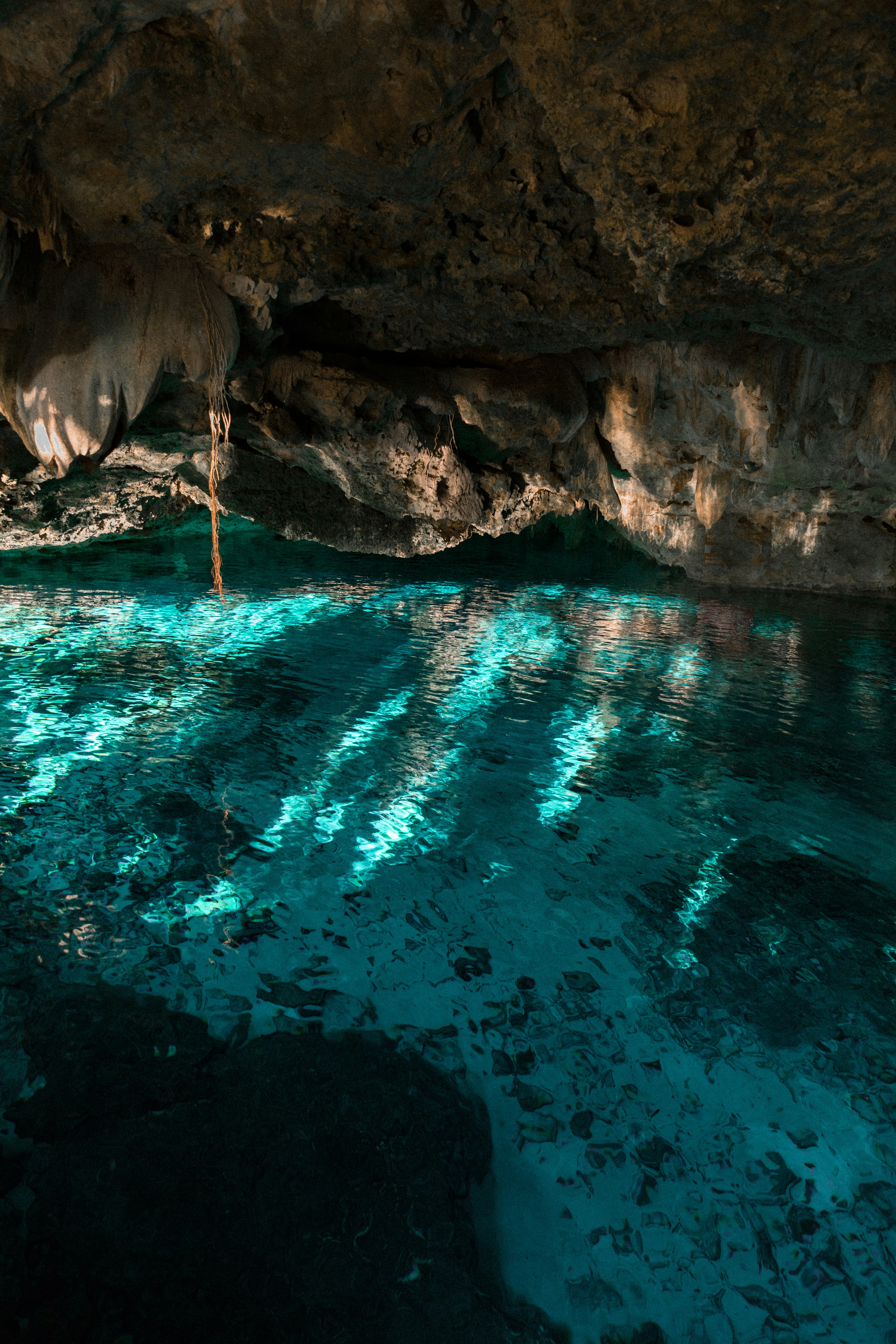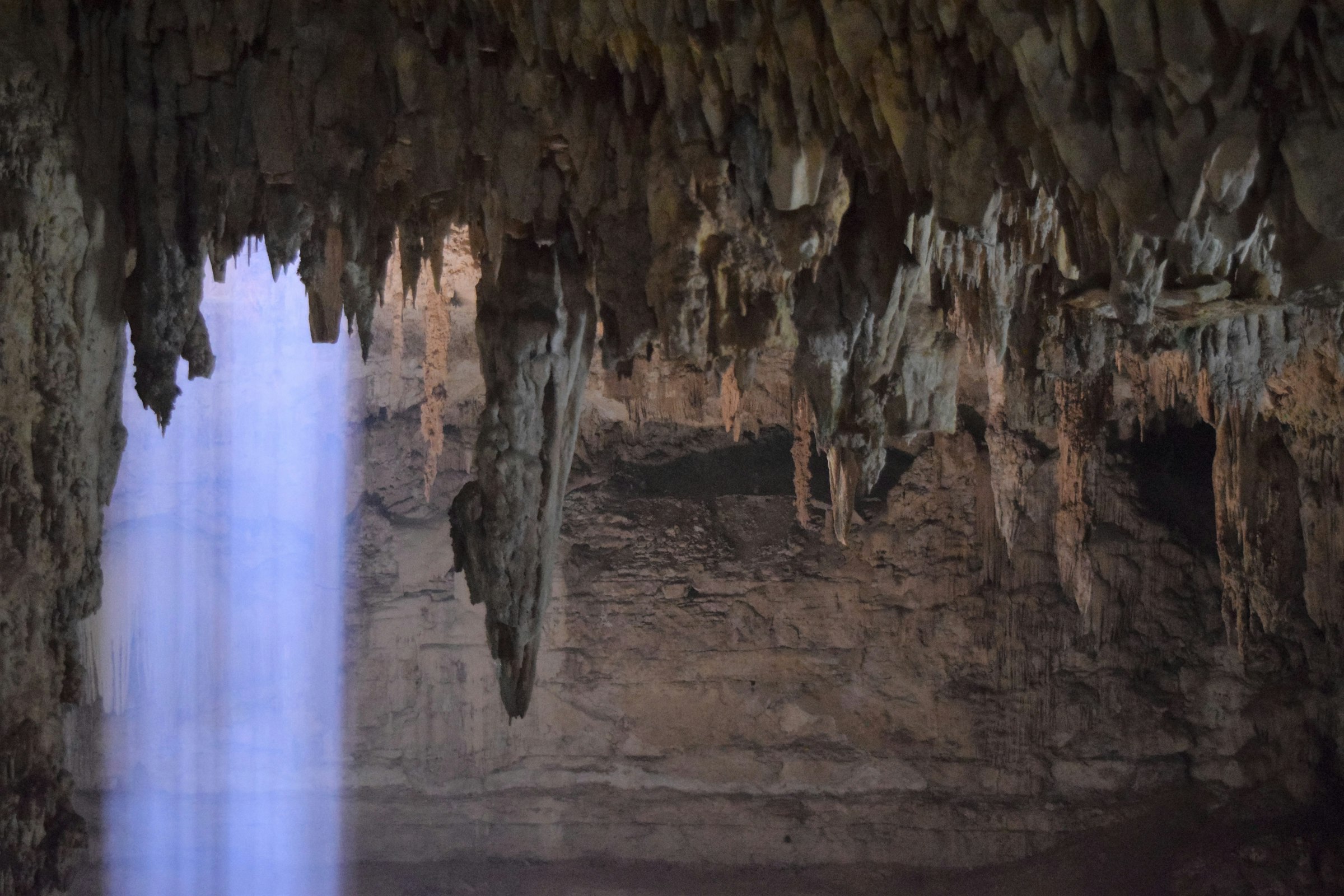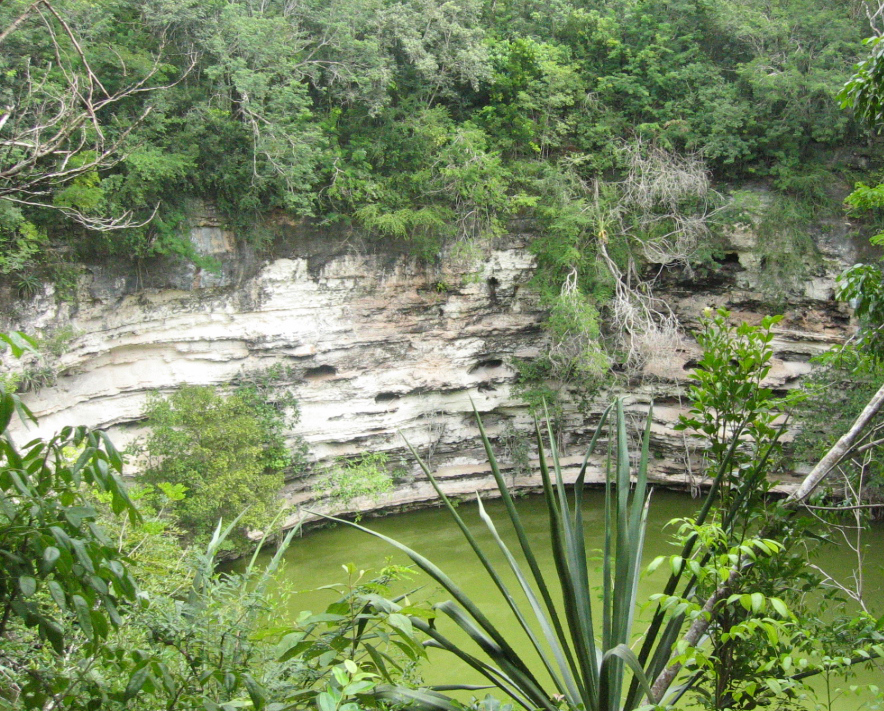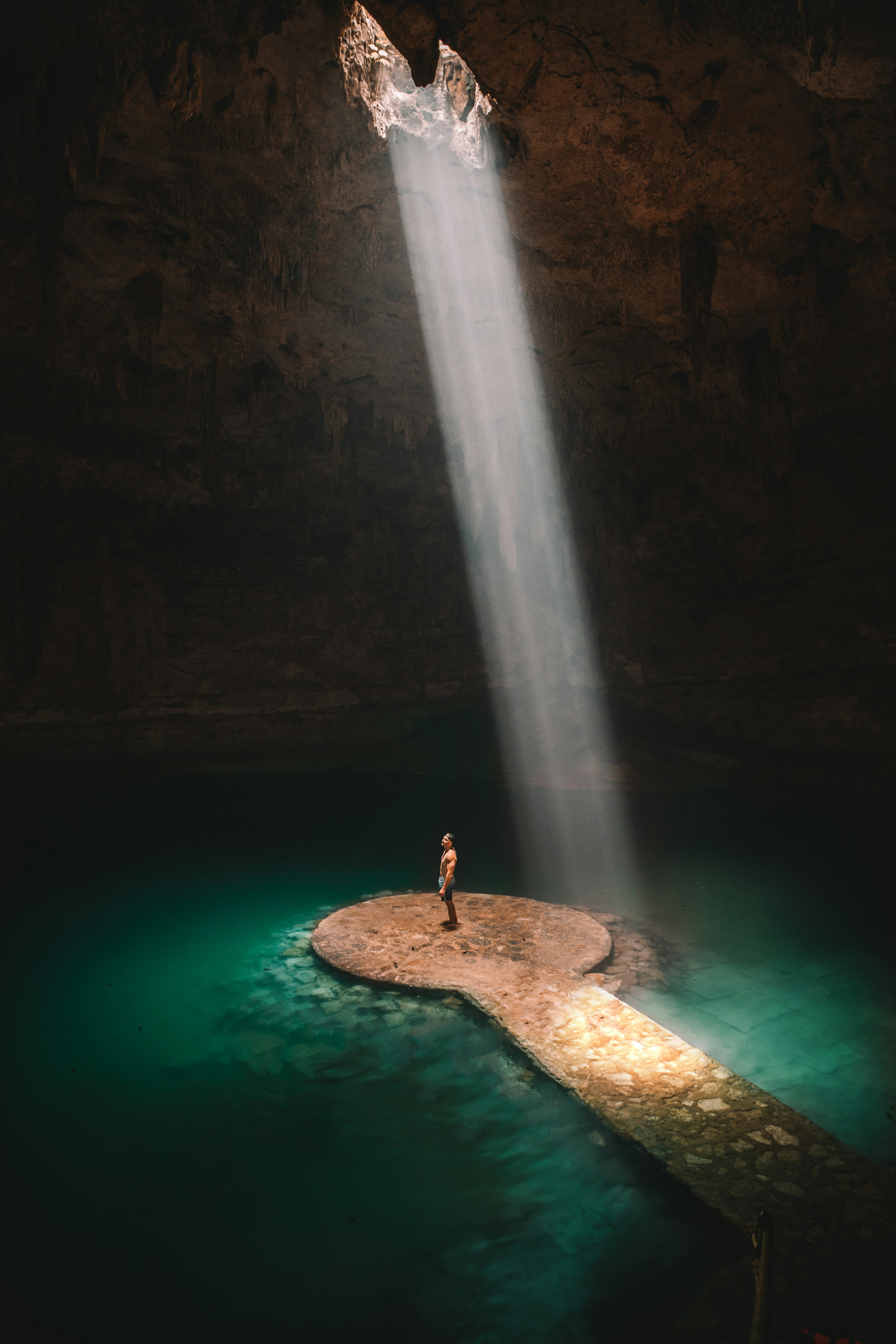
Cenotes: The Yucatán Peninsula’s Hidden Treasures
The Yucatán Peninsula is world famous for its white sand beaches and resorts at Cancún and Playa del Carmen. But further inland and hidden by lush jungles, there are thousands of natural, freshwater pools called cenotes. Cenotes offer serene sanctuary, adventure, and a taste of Mayan history for curious explorers. This post covers all there is to know about cenotes and directions to one particular inspiring one called Cenote Yokdzonot found near Chichén Itzá.

What is a cenote?
Cenotes are freshwater pools that were formed naturally from collapsed limestone. The Yucatán Peninsula is mostly made up of limestone – a rock so porous that rain water filters right through and collect underground.

Fun fact: There are no rivers that run above ground on the Yucatán Peninsula! This is because the bedrock of the Yucatán Peninsula is mostly made up of porous limestone.
Over time, some of the limestone dissolves from all the water that filters through it. This causes the bedrock to destabilize. Cenotes are formed when limestone collapses and reveals the freshwater pool underneath.

There are over 7,000 cenotes on the Yucatán Peninsula. It’s no surprise that they come in different forms and sizes. There are open-air, semi-open, and closed cenotes.

The vibrant colour of the water is a striking feature of cenotes. This is a result of the water having been purified while filtering through layers of limestone. Open-air cenotes are home to vitamin and mineral-rich algae that nourish your skin and gives the water that turquoise hue.

Travel tip: since cenotes are home to tiny fish and mineral-rich algae, consider taking a shower before jumping into the water. Cenotes are delicate ecosystems and chemicals from sunscreen, bug repellant and cosmetics may poison that ecosystem.
Cenotes and their importance to the Mayans
These freshwater pools were sacred to the Mayan civilization. In addition, they used them as fresh water sources for their cities.

Travel tip: if you are planning a visit to a Mayan archaeological site on the Yucatán (Chichén Itzá, Ceba, Palenque, Ek Balam, Uxmal just to name a few), I recommend planning a cenote swim after your visit!
Cenotes in Mayan Religion
The Mayans viewed certain cenotes as gateways to the underworld – Xibalba. They also believed that Chaac, the Mayan god of rain, lived at the bottom of these sacred wells. Human skeletons, gold, jade, copper, pottery and other valuables have been found in particularly important cenotes. It is believed that these items were dropped by Mayan shamans as offerings to Chaac in hopes that the Mayans would be blessed with rain and good harvest.
For the perfect complement to your cenote adventure, check out my 5 Tips for Visiting Chichén Itzá.

Fun fact: Cenote is derived from the Mayan word dzonot meaning “well”.
Cenotes on the Yucatán today
As previously mentioned, there are thousands of cenotes on the Yucatán Peninsula. Some have become VERY popular tourist attractions. Depending on which cenote you choose to visit, you can snorkel, dive or go spelunking through the underground river systems that link the cenotes.

Huge cenotes close to Mayan archaeological sites have been fully outfitted for tourism with plenty of amenities. These cenotes attract tourists by the bus load. Cenotes such as Ik Kil, Dos Ojos, Calavera and Suytun are super popular and are prevalent on social media.

Personally, I like to find hidden gems that are off the beaten path when I travel. If you’re like me, then I’m going to let you in on a secret cenote that I found inspiring in many ways…
Cenote Yokdzonot Near Chichén Itzá
During my stay at the Hacienda Chichén, I had asked the concierge for nearby cenote recommendations. This is how I came to know about Cenote Yokdzonot which is near Chichén Itzá.
Where is Cenote Yokdzonot?
The village of Yokdzonot is about a 20 minute drive from Chichén Itzá on the free highway. Tourist buses coming from Chichén Itzá do not stop here as Cenote Ik Kil is closer to the ruins and is better set up for mass tourism. Therefore, you won’t come across huge crowds at Yokdzonot. In addition, the entrance to the cenote is so inconspicuous that I drove past it three times!

Travel tip: I highly recommend skipping bus tours to a cenote and taking a taxi or renting a car instead. This way, you can spend as much time at the cenote and avoid crowds.
Who operates Cenote Yokdzonot?
The cenote is maintained by a cooperative of Mayan women from the village of Yokdzonot. A cooperative of Mayan women from the village of Yokdzonot maintains the cenote.All proceeds from the entrance fee goes directly to the benefit of the local community. The story behind the cenote (and the beautiful ecological park built around it) is quite inspirational.
Realizing that they can’t 100% rely on their farms for income, the women of Yokdzonot (Mayan for ‘town over the cenote’) formed a co-op to clean up the town’s cenote and attract tourism to their village. For 2 years, they gathered and cleared the area around the town’s cenote after completing their household chores. They then hired engineers to make the cenote accessible to the public. This work was so intensive that many became discouraged and dropped out of the co-op. Of the original 50 members of the Zaas Koolen Haá (Mayan for ‘clean water’) co-op, only 12 women and 5 men remain.

What to expect at Yokdzonot
Entrance fee was 80 MXN for foreigners (the locals get a 10 MXN discount). I arrived at Yokdzonot at noon and was the only one there!
Life jackets are mandatory as the cenote is about 45m deep. A young lady guided me towards the change rooms. Right away, I felt the care that the co-op puts into the maintenance of the cenote and ecological park.
After the change rooms, my attendant guided me towards the outdoor showers. Because the cenote serves as a fragile ecosystem to marine life, you cannot go for a swim without taking a shower first.
On the way down, I passed the restaurant run by the co-op. It serves local Yucatecan cuisine. The food smelled delicious!

There is a 22 m descent from the entrance down through some steep, wooden stairs to get to the cenote. The water is a dark blue colour and turns a vibrant turquoise when it catches the sun. It is cool to the touch when you first jump in. The cenote is open-air and is about 40 m wide and 45 m deep. Schools of tiny fish live in the water and you can see them swimming around you as you take a dip.
As I floated on the pristine waters, I looked up at the tree roots and vines hanging down from the ground above Cenote Yokdzonot. I also observed the tiny birds who lived within the crevices of the cenote walls tirelessly flying the full diameter of the cenote over and over again in perfect harmony.
When is the best time to visit?
I arrived at the cenote right at noon and had the place to myself. I’m guessing everyone else was at lunch during that time. From what I heard, Cenote Yokdzonot rarely gets busy because of its proximity to the more touristy Cenote Ik Kil so timing may not matter all that much.

In general though, the best time to visit the Yucatán is November to April. The Yucatán has a tropical climate year round. Note that the rainy season, sometimes accompanied by hurricanes, occurs between June and October.
What to bring to Cenote Yokdznot
As previously mentioned, the cenote is home to a delicate ecosystem. If you are planning on taking a swim, I recommend NOT using sunscreen, insect repellent or any other cosmetic products prior to your visit. You may want to pack these items for after your swim.
In addition to the restaurant, there snacks and refreshments available for purchase at the exit. So there is no need to pack snacks unless you absolutely wanted to bring your own.
I recommend packing the following:
- Cash (for the entrance fee and food)
- Bathing suit
- Towel
Like it? Pin it!

Have you ever been to a cenote? Do you have any questions Cenote Yokdzonot near Chichén Itzá? I’d love to chat via the comments below.
